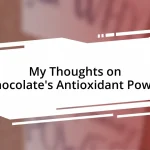Key takeaways:
- Store chocolate in a cool, dry place (ideal temperature: 60-70°F) to prevent blooming and maintain texture.
- Airtight containers are essential for preserving chocolate quality by keeping out moisture and strong odors.
- Monitor chocolate freshness by checking texture and aroma regularly; take notes on purchase dates to track shelf life.
- Employ desiccant packets to control humidity and avoid sugar bloom, ensuring chocolate stays fresh longer.

Understanding chocolate storage needs
When I think about storing chocolate, I often recall the excitement of opening a fresh bar after a long day. The texture and aroma can change drastically if not stored properly, which makes understanding its storage needs essential. Chocolate thrives best in a cool, dry place; a temperature between 60-70°F is ideal. How often have you grabbed a bar only to find it has bloomed, losing that delightful sheen? That white powdery film can be a letdown, but it’s actually just sugar that has risen to the surface due to fluctuations in temperature.
It’s fascinating how chocolate reacts to its environment. For instance, humidity can be a real enemy – it can lead to that unappetizing sticky texture. One time, I left a cherished dark chocolate bar in a slightly too humid pantry. The disappointment I felt when it became tacky was palpable! Remember, sealed containers can help maintain the right balance. So, have you thought about where you’re keeping your favorite treats? Your chocolate deserves a cozy spot, away from strong odors and sunlight.
Perhaps you’ve noticed the delightful varieties of chocolate, each with its own quirks. For example, milk chocolate is more sensitive to temperature than dark chocolate, which is a bit more forgiving. I’ve been there, stashing away leftover chocolates, only to retrieve them later and realize they didn’t taste as magic as they did at first. Understanding these nuances in storage can elevate your chocolate experience significantly. It’s not just about keeping it safe; it’s about every rich, velvety bite being as luscious as possible!

Ideal temperature for chocolate
Chocolate is quite sensitive to temperature, and maintaining the right conditions can make a world of difference. I remember a summer afternoon when I left a luscious bar of dark chocolate in my car while running errands. When I returned, the chocolate had become a melty, gooey mess—all that creamy goodness lost because of a few hours in the heat! That experience taught me just how crucial the temperature range of 60-70°F is for safeguarding the integrity of chocolate.
When it comes to chocolate, even slight changes in temperature can lead to unwanted results. My friend once tried to hastily refrigerate her chocolate after forgetting it in a warm kitchen, only to end up with a chalky texture that was a far cry from the silky-smooth experience she intended. It’s essential to remember that a controlled environment not only preserves the taste but also the texture and appearance – ensuring that each bite is just as delightful as the first.
To add another layer to this topic, variations in types of chocolate call for slightly different treatment. For instance, I’ve noticed that my favorite white chocolate exhibits a tendency to soften more easily than dark chocolate. When I carefully stored both side by side, the white chocolate consistently needed a cooler space. It’s this awareness of the unique characteristics among chocolate varieties that can elevate your chocolate experience, allowing for every piece to be enjoyed to its fullest potential.
| Type of Chocolate | Ideal Temperature Range |
|---|---|
| Dark Chocolate | 60-70°F |
| Milk Chocolate | 60-65°F |
| White Chocolate | 60-65°F |

Best containers for chocolate
When it comes to the best containers for chocolate, the choice is crucial for preserving its quality. I’ve found that airtight containers work wonders, keeping unwanted moisture and odors at bay. I still remember storing my prized artisanal chocolate in a plain jar; the scent of spices from nearby pantry items seeped in, altering its delicate flavor. It was a hard lesson learned!
Here are some great container options for storing chocolate:
- Airtight Glass Jars: These maintain freshness and prevent humidity damage.
- Plastic Containers with Sealing Lids: Lightweight and stackable, great for easy access.
- Vacuum-Sealed Bags: Perfect for longer storage, especially if you buy in bulk.
- Food-Safe Tin Boxes: A classic choice, keeping chocolates protected and adding a touch of charm.
For me, using these containers has not only protected my chocolate but has also added an element of organization to my kitchen. It’s like creating little treasure chests of chocolate joy!
I also highly recommend avoiding transparent containers. While they might look appealing, exposure to light can degrade chocolate quality over time. Trust me, I’ve had my fair share of chocolate that lost its luster because it was kept in a clear bowl on the countertop. Now, I opt for opaque containers that keep my treats hidden and safe from the sun. It’s a simple switch, but boy, does it make a difference in preserving the preciousness of every bite!

How to prevent moisture damage
Moisture is a chocolate’s worst enemy, and I’ve learned that the hard way through a few sticky situations. I once had a beautiful collection of truffles that I stored poorly, leading to a disheartening case of bloom—when a whitish coating forms on the chocolate’s surface. It was such a letdown, especially considering the effort I put into selecting those delicacies! To prevent moisture damage, I’ve found that keeping chocolate in a cool, dry place is essential—think of it as giving your chocolate a safe haven.
Using those airtight containers really made a difference for me as well. I’ve noticed that sealing my chocolate helps keep humidity away, but taking the extra step of adding a small desiccant packet can be a game changer. Whenever I come across a packet, I slip it in with my chocolate stash, just to be extra cautious. Isn’t it fascinating how such a tiny thing can have an enormous impact on maintaining freshness? After all, you wouldn’t want to spend your precious time choosing the perfect chocolate only to have it turn into a soggy mess.
If you ever find yourself in a humid environment, it’s best to skip the fridge altogether for storing your chocolate. There was a time when I thought refrigeration was a foolproof way to protect my chocolates from moisture. But in reality, it only caused condensation and ruined their texture. Instead, I recommend placing chocolate in a air-conditioned room. It’s all about finding that sweet spot—literally and figuratively! What clever storage techniques do you use to protect your chocolate?

Avoiding strong odors in storage
I’ve often noticed how strong odors can easily invade chocolate if it’s not stored properly. It’s funny how something as simple as an onion or garlic in the fridge can drastically change the flavor of your favorite chocolate bar. Once, I made the mistake of keeping chocolate too close to some strongly scented cheeses, and it left my treats tasting more like a culinary science project than the delicious confections I hoped for. Ensuring that your chocolate is stored in a separate, fragrance-free environment can truly preserve its original taste.
Keeping chocolate in airtight containers is a huge part of avoiding these odor issues, but there’s more to it. I’ve found that wrapping chocolate in parchment paper or plastic wrap before placing it in the container acts as an extra layer of protection. When I discovered this trick, it felt like I had found a little hack that truly safeguarded my chocolate’s integrity. You really don’t want chocolate that tastes like the remnants of last week’s dinner!
It’s also essential to be mindful of where you decide to store your chocolate. I’ve learned that placing chocolate near strongly aromatic foods, even if they’re not directly touching, can lead to unexpected flavor combinations. Have you ever bitten into a piece of chocolate only to be hit with a whiff of something totally out of place? It’s unmistakable! I now make a habit of keeping my chocolate in a dedicated corner of my pantry, far away from anything that boasts a strong scent. That way, every bite remains a pure, unadulterated experience!

Monitoring chocolate freshness
I think monitoring chocolate freshness is essential for truly enjoying its rich flavors and textures. One time, I opened a box of chocolates after a few months only to find they had lost their signature snap. I had stored them just out of sight, assuming they would stay fine without checking in. This experience taught me the importance of a little chocolate TLC—like checking periodically for changes in texture or aroma. Have you ever bitten into a chocolate that tasted stale? It’s such a disappointment!
Another useful tip I’ve picked up is to take notes on the purchase date and type of chocolate. I keep a little inventory, noting when I bought each chocolate bar or truffle. It’s amazing how this small habit can help track freshness. For example, dark chocolate can last much longer than milk chocolate, which can spoil quicker due to its dairy content. That way, I not only ensure I enjoy my treats at their best but I also get to savor each kind within its prime window. Have you considered keeping a chocolate diary?
Lastly, I’ve realized that the visual cue of blooming can also tell us a lot about freshness. When I first noticed this phenomenon—chocolate losing its glossy sheen and developing a powdery texture—I panicked. But now, it’s simply a signal, not the end of the world. While it’s entirely edible, it does affect the taste, and knowing that can help me decide when to finish off a bar or batch of chocolates. So, have you ever noticed that bloom in your chocolate stash? It’s about being more present with what we indulge in.

Maximizing chocolate shelf life
Maximizing the shelf life of chocolate requires a bit more diligence than most people realize. I learned this the hard way when I discovered that simply tossing my favorite bars into a drawer didn’t cut it. After a few months, I opened that drawer expecting a sweet treat, only to be greeted by a dull, faded wrapper and chocolate that had lost its luster. I now make it a point to store chocolate in a cool, dry place, ideally around 65-70°F (18-21°C), which really helps maintain its quality.
Another crucial tip I’ve embraced is paying attention to humidity levels. Chocolate thrives best in stable conditions, and I was shocked to find out that too much moisture can lead to sugar bloom—a white, dusty appearance that signals trouble. The first time I noticed this, I thought I had ruined a premium chocolate bar. It turns out, proper storage in a climate-controlled environment can prevent this unsightly issue. Have you ever had to salvage a treat due to an unexpected bloom? Now, I proudly invest in desiccant packets to control moisture in my storage area; it’s a small step that makes a huge difference.
Lastly, I’ve become a fan of chocolate rotation, much like I do with my pantry items. I always place newer bars at the back and bring older ones to the front—a simple habit that prevents rotating out the same neglected chocolate. It’s amusing how often I find myself rediscovering a hidden gem I had forgotten about! This practice not only helps me enjoy my chocolates before they reach their peak but also keeps my stash fresh and exciting. Do you have any clever storage tricks to ensure your chocolate never languishes in the shadows?














